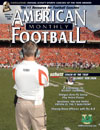AMERICAN FOOTBALL MONTHLY THE #1 RESOURCE FOR FOOTBALL COACHES
Article CategoriesAFM Magazine
|
Shotgun Zone Fly Sweep Play Action Passesby: Michael Parker© More from this issue For any team that wants to establish the run, a good play action pass alternative is crucial. Play action keeps defenses from over-aggressively playing the run. This is especially true of the newer forms of the shotgun spread offense that are becoming the staple at the high school and college level. Coach Bryon Hamilton, at Foothill High in California, has found tremendous success in his own hybrid spread offense. One of Foothill’s favorite run plays is the Fly Sweep (outlined in depth in the December issue of AFM). The play action passes off the Fly Sweep that Hamilton has found the most successful (in the past few years of using this system) are the Waggle and the Dart Screen. Using these two passes as a complement to that particular run action will help any system that utilizes the Shotgun Fly Sweep. ....The full article can only be seen by subscribers. Subscribe today!
|
|
|||||||
| HOME |
MAGAZINE |
SUBSCRIBE | ONLINE COLUMNISTS | COACHING VIDEOS |
Copyright 2025, AmericanFootballMonthly.com
All Rights Reserved





